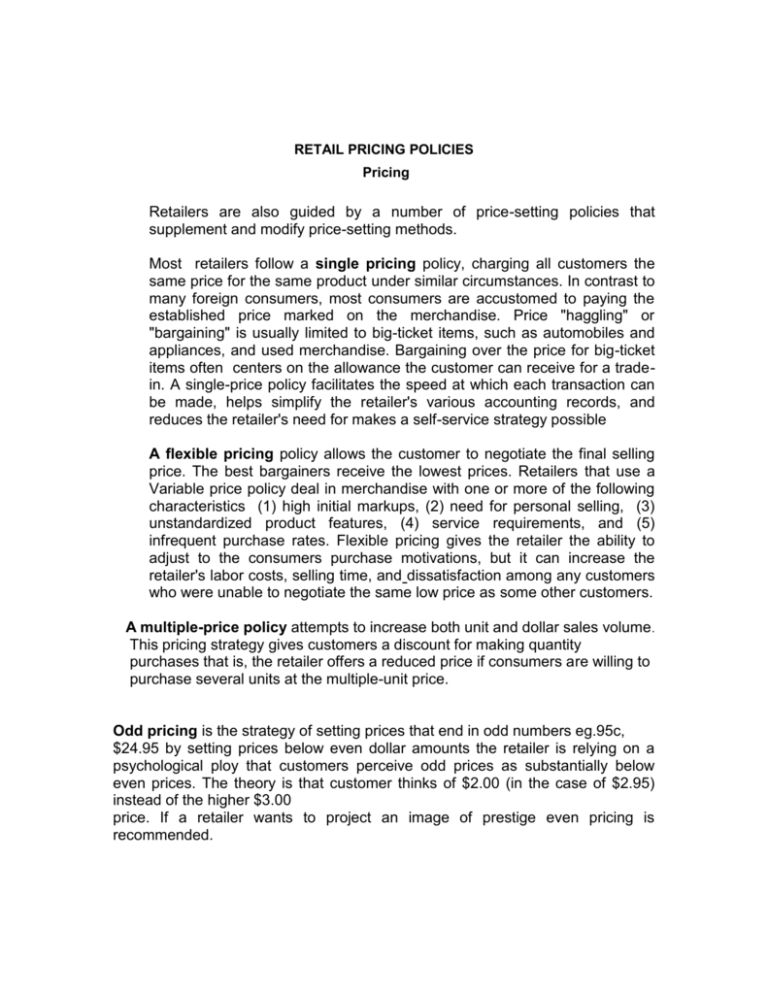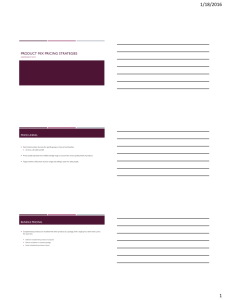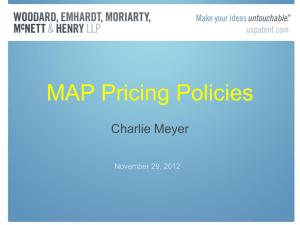RETAIL PRICING POLICIES
advertisement

RETAIL PRICING POLICIES Pricing Retailers are also guided by a number of price-setting policies that supplement and modify price-setting methods. Most retailers follow a single pricing policy, charging all customers the same price for the same product under similar circumstances. In contrast to many foreign consumers, most consumers are accustomed to paying the established price marked on the merchandise. Price "haggling" or "bargaining" is usually limited to big-ticket items, such as automobiles and appliances, and used merchandise. Bargaining over the price for big-ticket items often centers on the allowance the customer can receive for a tradein. A single-price policy facilitates the speed at which each transaction can be made, helps simplify the retailer's various accounting records, and reduces the retailer's need for makes a self-service strategy possible A flexible pricing policy allows the customer to negotiate the final selling price. The best bargainers receive the lowest prices. Retailers that use a Variable price policy deal in merchandise with one or more of the following characteristics (1) high initial markups, (2) need for personal selling, (3) unstandardized product features, (4) service requirements, and (5) infrequent purchase rates. Flexible pricing gives the retailer the ability to adjust to the consumers purchase motivations, but it can increase the retailer's labor costs, selling time, and dissatisfaction among any customers who were unable to negotiate the same low price as some other customers. A multiple-price policy attempts to increase both unit and dollar sales volume . This pricing strategy gives customers a discount for making quantity purchases that is, the retailer offers a reduced price if consumers are willing to purchase several units at the multiple-unit price. Odd pricing is the strategy of setting prices that end in odd numbers eg.95c, $24.95 by setting prices below even dollar amounts the retailer is relying on a psychological ploy that customers perceive odd prices as substantially below even prices. The theory is that customer thinks of $2.00 (in the case of $2.95) instead of the higher $3.00 price. If a retailer wants to project an image of prestige even pricing is recommended. Unit pricing- given the wide range of package shapes and sizes together with the diversity of price tags and product labels, many customers can’t determine which purchase is the better value for money. As a result, some retailers use unit pricing to eliminate uncertainty. Unit pricing is the retailing practice of showing prices on a per unit basis. Customers are then able to compare prices and select the best value. Price lining Price lines are specific pricing points established within pricing zones. A menswear retailer may attempt to establish three pricing zones for men’s suits. *The low range under $150 *The mid range between $150-250 *The high range above $250. Also suppose the retailer has targeted the mid-price customer . Then the retailer might establish price lines at $139.95.$199.95 and $229.95. Everyday Low pricing is the policy of maintaining price points at the same low year-round. By avoiding the pricing Yo-yo of mark-ups and markdowns the retailer can establish price credibility through consistency. It usually involves cutting prices by 20-40%. This pricing strategy requires the retailer to be able to achieve everyday low costs. Cost reductions are possible because of fewer staff for ticketing and reticketing of stock, less labour for display set up and maintenance, reduced advertising and promotional costs, fewer returns and markdowns when items are returned. Leader pricing is the strategy of selling key merchandise items below their normal mark-up, or in some cases below cost. The main objective of leader pricing is to attract customers to the store, in the hope that they will purchase other merchandise that has normal mark-ups. Price matching. A promise to match the lowest advertised price a customer can find .It is a stores insurance policy that assures customers they will not miss out on the price deals offered by other retailers.






